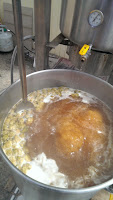Zymurgy had an article on pumpkin ales this issue and it reminded me that "tis the season" and now was the time to start brewing if I wanted my beer to be ready for the holidays. No clever name this time sorry.
Recipe Specifications:
- Batch Size: 10.00 gal
- Boil Size: 13 gal
- Predicted OG: 1.070 SG
- Boil Time: 90 Minutes
- 19.0 lb Pale Malt (6 Row) US
- 1.00 lb Pilsner Malt
- 1.00 lb Victory Malt
- 1.00 lb Crystal-60 Malt
- 1.25 lb Melanoidin Malt
- 2.00 oz Cascade, US 9.5% Whole Leaf Hops
- 6.00 lb Canned Pumpkin
- 2.0 lb Maple Syrup
- 2.0 lb Wildflower Honey
- 1.0 tsp. Pumpkin Pie Spice
- WLP565 Saison Ale
- WLP008 East Coast Ale
Thursday August 22, 2013 I went to Brew Brothers and bought my ingredients. I was splitting this batch of beer so I needed to do two starters. In order to do this I bought another 2000ml Erlenmeyer flask. I only have one stir plate so I did put the saison yeast on the stir-plate and the east coast ale I just left stationary since it is a more active yeast than the saison. This way the saison will be a little more active when its time to pitch.
Brew Procedure:
On Saturday August 25th, 2013 I got up early to brew. First I calculated how much mash water I needed. total grain weight was 19.4 lbs. So to calculate mash water I used the following calculation:
23.25 lbs grain x 1.75 qt/lb = 40.6875 qt. x 1/4 gallon/qt = 10.17 gal
 |
| Mash out |
| 6 lbs of pure pumpkin |
The recipe called for the pumpkin to be dissolved in about a gallon of water heated and then poured in the mash-tun. It called for 6 lbs
which is really inconvenient since the cans of pumpkin came in 15 oz. cans, so I had to buy 7 and only use about 6.5 cans. I
placed my old extract brew kettle on a burner and heated it up while I dumped the cans of pumpkin in. After the pumpkin was all dissolved, I filled the mashtun with 10 gallons of water and began heating it to 169 °F. After the water reached 169 °F I added the grain and began vigorously stirring. After the mash was thoroughly stirred I added the pumpkin on top and let the mash temperature stabilize. After a few minutes the temperature had dropped down to a 185°F and then stabilized at 154°F . I placed the insulation jacket around the mashtun and let it sit for a full hour.
| Pumpkin Mash |
 |
| Nice Orange Boil |
Hops/Ingredients Schedule:
| Quantity | Ingredient | Boiled For |
| 1.0 oz. | Nugget | Entire 90 Min. boil |
| 2.0 lb. | Maple Syrup | Last 5 min of boil |
| 2.0 lb. | Wildflower Honey | Last 5 min of boil |
| 1.0 tbs. | Pumpkin Pie Spice | Flameout |
| Standard and Saison |
The final aroma was awesome you could definitely smell the pumpkin and the pie spice but it was not overwhelming just a pleasant note.
INITIAL WORT GRAVITY: 1.072
UPDATE: 8/26/13 Fermentation has really taken off and it has almost completed. It was bubbling about ever second withing 4 hours of pitching the yeast.
UPDATE: 8/31/13 Fermentation has basically stopped and I am transferring to secondary before I leave for my honeymoon. This will give it a couple weeks to clarify since I forgot to add the whirlfloc during the boil. The standard pumpkin ale had a gravity reading of 1.016 and the saison came in at 1.010.
Saison: 131.25*(1.072-1.010)=8.1375% ABV
Standard: 131.25*(1.072-1.016)=7.35% ABV
Good Lord these are much stronger than I was anticipating I guess adding 4 lbs of extra fermentable sugars will do that. They still taste kind of young so I am not going to pass judgement on them. There was a HUGE yeast cake in the bottom of both of them and its still pretty yeasty flavored. Hopefully a couple weeks in secondary will mellow that out and refine the taste a little more.
UPDATE: 9/19/13 Got back from my honeymoon and bottled the standard pumpkin with yellow caps unfortunately I didn't have enough bottles to do the Saison so I will have to wait until later. I took a gravity reading and added 4.0 os. of priming sugar.
Standard: 131.25*(1.072-1.014)=7.6125% ABV
The taste was not what I was expecting but hopefully it will mellow out a little the spice flavor is a little intense.
UPDATE: 9/23/13 I sanitized enough bottles this time to bottle the saison with the red caps. I took a gravity reading and then added 4.0 oz. of priming sugar to the bucket.
Saison: 131.25*(1.072-1.006) =8.6625% ABV
This has a bit of a hot alcohol flavor but overall its pretty good It may taste better carbonated.
UPDATE: 9/23/13 I sanitized enough bottles this time to bottle the saison with the red caps. I took a gravity reading and then added 4.0 oz. of priming sugar to the bucket.
Saison: 131.25*(1.072-1.006) =8.6625% ABV
This has a bit of a hot alcohol flavor but overall its pretty good It may taste better carbonated.

